|
Circular Quay
The Tank Stream Fountains
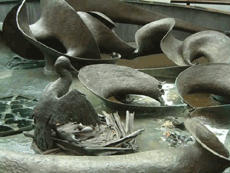
1981. A series of fountains recalling man's past dependence on this stream as the colony's first source of water, and the colony's links with the life around it. The fountains depict a variety of flora and fauna which used to be found on the Tank Stream's banks. Sculptor: Stephen Walker.

Tankstream - Into the Head of the Cove ...

City Streets
Tankstream - into the head of the cove... celebrates this stream which commenced in marshes near Pitt Street Mall, its importance in the founding of the city and its continued survival under the city streets. The artwork marks the course of the Tank Stream, Sydney's first water supply, with five key sites through the city from Pitt Street Mall to Alfred Street. Coloured glass modules lit from within evoke the existing subterranean stream flowing beneath the city streets. Captain Watkin Tench, Captain of the marines of the first settlers at Port Jackson, wrote about the selection of Sydney Cove as the first site of settlement, recorded the rise and flow of the stream and his vision of grandeur of the settlement. Created by Lynne Roberts-Goodwin.
Haymarket
Railway Square fountain
Broadway

The Rocks/Millers Point
Dreadnought Boys Memorial
A wall plate behind the Orient Hotel in Kendall Lane, it commemorates the Dreadnought Scheme which brought out 5,595 boys aged 14 to 18 to Sydney as apprentices. The first boys arrived in 1911. The memorial was erected by the Dreadnought Old Boys Association in 1984.
Boer War Memorial
A stone memorial, erected in 1902 on Observatory Hill near a rotunda, it honours Australian servicemen who served in the Boer War in South Africa (1899-1902).
First Impressions Monument
The Rocks Square.
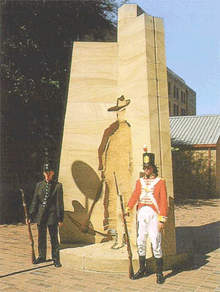
A memorial to the European pioneers - a soldier, farmer and convict - who founded Sydney, many of whom lived in The Rocks. A larger than life sculpture of a reminder of European settlement.
Circular Quay
Writers Walk

Set into the pavement at regular intervals around Sydney Cove are a series of circular plaques which honour writers past and present. Many are Australians, others, like Charles Darwin and Mark Twain, are well known overseas writers who in their lives had a connection with Australia.
Bust of Captain Phillip

A bronze bust of the first governor of NSW, Arthur Phillip, which is sited on a plinth in First Fleet Park in front of the Museum of Contemporary Art.
Martin Place
Dobell Memorial Sculpture
Martin Place, Sydney
The work of Bert Flugelman, this stainless steel sculpture depicts upended cubes. A tribute to artist William Dobell, it was funded by donation by from artist Lloyd Rees and public subscription.
Sydney Cenotaph

Constructed in 1929, this Art Deco Cenotaph is the site of Sydney's annual Anzac Day war remembrance service. The bronze statues of a soldier and sailor, which are mounted on a granite base, are the work of sculptor Bertram MacKennal.
More information
Passage
A footprint of a Georgian house that once stood in Martin Place is marked out by black granite paving tiles and metal grilles, through which a light mist rises every ten minutes, evoking the ghostly spaces once occupied by previous residents. The three bronze bowls, reflection pools and fountains represent the Georgian washrooms which were placed at the back of the house. Created by Anne Graham.
Phillip Street
Edge of Trees

Museum of Sydney, 37 Phillip Street, Sydney
Contemporary sculpture located in the forecourt of the Museum of Sydney, it is a collection of 29 sandstone, wood and steel pillars which symbolise the first contact between Aboriginal and European peoples. Organic material such as hair, ash, feathers, bones, shells etc. fill incisions in the pillars. The sound of the native tongue of the indigenous people who lived in the Sydney district when the First Fleet arrived can be heard as visitors read inscriptions of the names of the First Fleeters and those of of botanical species in both Latin and the indigenous language.
Hyde Park
The Anzac Memorial
1929-34 . Hyde Park

The work of local Art Deco architect C. Bruce Dellit, featuring the Tomb of the Unknown Soldier and a reflecting pool. Built to commemorate all Australians killed in wars, it features a downstairs photographic and military memorabilia exhibition. The 30 metre high memorial is made of reinforced concrete and faced by red granite from Bathurst. The sculptures are the work of Raynor Hoff (1894-1937), an art instructor at Sydney Technical College who himself served in France during World War I. The Hall of Memory is faced with white marble and features a dome ceiling decorated with 120,000 stars, representing each volunteer who enlisted during World War I. The Hall focuses on a bronze statue (below) by Hoff featuring a dead soldier carried on a shield by his mother, sister, wife and child. The outdoor Lake of Reflection is lined by poplars from Northern France. Pines and shrubs from Gallipoli, Turkey, line other approaches.

Busby's Bore Fountain
Commemorates Busby's Bore, the city's first piped water supply which emptied into water storage facilities at this site. Completed in 1837, Busby's Bore was a 4.4 km tunnel which channelled water from bores on Lachlan Swamp (Centennial Park) to the corner of Elizabeth and Park Streets, where horse drawn water carriers dispersed it to the community. Civic engineer John Busby conceived the idea and supervised its construction.
Emden Gun
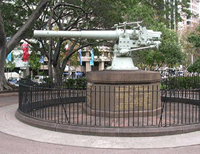
Cnr College & Liverpool Sts. A 4-inch naval gun from the German raider Emden, sunk off the Cook Islands by HMAS Sydney on 9th November 1914. The gun commemorates this naval action.
Cannon
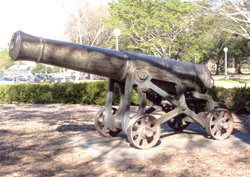
An iron cannon, dated 1806, is mounted in the gardens near College Street and St Marys Cathedral, was originally part of the armament of Fort Macquarie, erected by Gov. Lachlan Macquarie on Bennelong Point. Cast at the Carron Works, Scotland, the cannon bears the royal cypher of King George III (G.R.) on the second reinforce. This type of cannon was common to shore batteries and H.M. ships of the 19th century until breach loading guns replaced them.
James Cook Statue
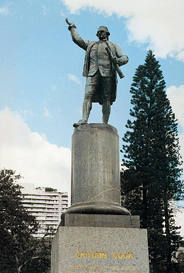
Hyde Park is home to a plethora of statues, fountains and memorials, yet none has a history as interesting as the statue of Lieutenant James Cook, the famous British Navigator who explored the east coast of Australia in 1770. The statue was erected in 1879 to mark the hundredth anniversary of Cook's death in Hawaii. Its creator was Thomas Woolner, an Englishman who had come to Australia in the hope of striking it rich in the Gold Rush in 1852 but had returned to England two years later after failing to find gold.
Whilst the statue's arrival from England was a major event in Sydney, the story surrounding its huge granite base is far more dramatic and noteworthy. The 15 tonne block of stone was hewn from Louitt's quarry at Moruya, a small town some 200 km south of Sydney, which would later supply the stone used to face the pylons of the Sydney Harbour Bridge. As there was no lifting tackle available, the granite block had to be rolled from the quarry to the schooner Settler's Friend, which was to carry the stone on its upper deck. The chunk of rock made the vessel so top heavy it became so hard to control that during the voyage it collided with a barque heading in the opposite direction. The two vessels became locked together and would have both sunk had it not been for a handful of men who used axes to separate them. Miraculously, both ships stayed afloat despite having suffered considerable damage. The Settler's Friend limped into Sydney harbour three days later with the granite block leaning precariously on the steeply angled deck. The statue was unveiled by the Governor Sir Hercules Robinson on 25th March 1879. During its early years, it could be seen clearly by seafarers travelling up the harbour towards Sydney Cove and became a welcome landmark they looked out for after months at sea.
The Archibald Fountain

A bronze and granite fountain commemorating the alliance between Australia and France during the Great War of 1914-18. Featuring figures from Greek mythology, it was created by Parisian sculptor François Sicard in 1932, having been bequeathed to the City of Sydney by JF Archibald, one of the founders of The Bulletin magazine.

A proponent of Australian art and literature, Archibald and the Bulletin popularised the works of Henry Lawson and Banjo Paterson among others, and it was his bequest that established the Archibald Prize for portraiture.
WB Dalley statue
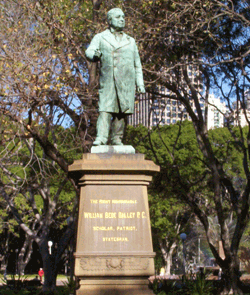
A life size statue of William Beade Dalley, who was Solicitor General, Attorney General, Acting Premier of NSW (1885) and a member of the Privy Council during his lifetime. The statue commemorating the son of a convict was erected by public subscription.
John Frazer Fountain

Erected opposite Sydney Grammar School in 1882, the bubbler fountain honours merchant and member of the Legislative Council (1874), John Frazer, who arrived in Sydney in 1840, aged 14.
'Fish' Fountain
A carved stone fountain, erected in 1888 and used these days by toddlers cooling their feet, it was donated to the people of Sydney by John Baptist Church of Redfern. The fountain is opposite Park Street.
Water, Fire & Earth Sculptures

Facing Elizabeth Street, these Polynesian-imaged sandstone carvings and a nearby water saucer are the work of sculptor Gerard Havekes as a memorial to Frederick J. Walker and other pioneers of primary industry in Australia.
Chess Board

The paved chessboard, which is available for players to use between 11.30 am and 2.15 pm daily, used to be located in Alfred Street opposite Circular Quay. It was moved to its present location because the large number of spectators watching games being played blocked passage of pedestrians on the surrounding footpaths.
Busby's Bore Fountain
Located opposite St James Road, the fountain, comprised of stone saucers, was designed by architect John Byron. It recalls Sydney's second water supply, a series of tunnels and above ground water channels built by engineer John Busby in the 1830s, which brought water from what are today the lakes of Centennial Park, to a distribution point in Hyde Park.
Masonic War Memorial
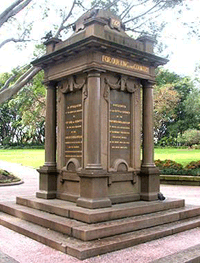
Located near the corner of Park and Elizabeth streets, it is probably the best-kept war monument in Sydney. It commemorates the 3010 members of Masonic Lodges who volunteered to fight in the Great War of 1914 to 1919. 501 of them 'made the supreme sacrifice'. Work it out, one in every six men who volunteered to fight in the war, was killed. This showed the enormity of the tragedy.
King George Fountain

Contemporary memorial fountain to Kings George II & III. The fountain is located in the Sandringham Garden. The garden, a memorial to the English kings George V and George VI, was opened by Queen Elizabeth II in 1954.
Art Gallery of NSW
Almost Once (Redhead/Blackhead)
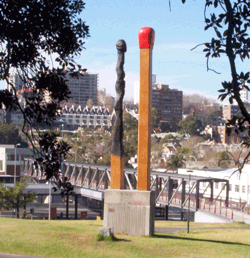
Brett Whiteley sculpture of blackbutt timber and fibreglass consisting of two large 'redhead' matches, one live and one burnt, on a concrete base (conceived in 1968 and finished in 1991).
The Offerings of Peace and War

Two massive sculptures, The Offerings of Peace and The Offerings of War (above), are the work of the English sculptor, Gilbert Bayes (1872-1953), 1926.
Henry Moore Reclining Figure
The reclining bronze is by the English sculptor, Henry Moore (1898&endash;1986), considered to be one of the greatest of all twentieth-century sculptors. The original plaster was made in 1975. This cast was purchased from the artist in 1981. |
Macquarie Street
William Shakespeare Memorial

Shakespeare Place - A rather elaborate group of statues featuring playwright William Shakespeare, quill in hand, surrounded by some of his characters such as Hamlet, Falstaff, Dorta, Romeo & Juliet (in an embrace). The bronze statues are the work of Australian sculptor Sir Bertram MacKennal (1826-1931) who also designed the Martin Place Cenotaph (1929) and Phoebes driving the horses of the sun above the entrance to Australia House in The Strand, London.
When it was unveiled, the memorial was located in front of the main entrance of the Mitchell Library as if to lure passers by to come inside for a good read. When the Cahill Expressway was built, the memorial was in its path and had to be moved to its present site - a traffic island in the middle of Shakespeare Place.
Matthew Flinders Statue
State Library of NSW
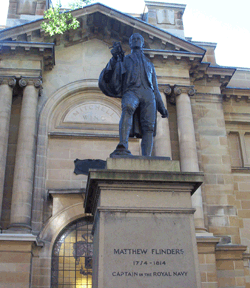
Bronze statue of the first person to navigate around Australia. On the windowsill of the State Library behind him is a bronze statue of his cat and travelling companion, Trim (below).
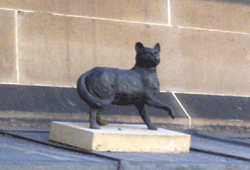
Sir Richard Bourke statue

This statue, erected in 1842, is located outside the Mitchell Library and is significant in that it was the first statue of its kind to be erected in Australia. Designed by EH Bailly, it honours Sir Richard Bourke, Governor of the colony of New South Wales from December 3, 1831 to December 5, 1837. A rather lengthy description of Bourke's career is inscribed on the statue's plinth. Bourke was an Irishman and a fully qualified barrister who was perhaps the most popular of all the colonial Governors. He brought many changes to the colony, not the least being his introduction of the British system of trial by jury, which effectively replaced the rule of military justice that had been in force since 1788. Bourke was an adventurous, energetic man, a trait reflected in the considerable amount of exploration of the Australian continent that was instigated during his term of office. He is also remembered for giving financial support to the various church denominations represented in Sydney. It was as a result of his generosity toward them that most of the churches of inner Sydney were built during his term of office.
Lachlan Macquarie statue

185 Macquarie Street - This memorial to the man who left his name on more roads and geographical features than anyone else stands in the grounds of Parliament House. The small, modern statue honours one of New South Wales' most famous governors who, during his term of office (1810-1821), turned Sydney from a backwater convict prison to a developing civic-minded community.
Sir Leslie Morshead memorial fountain

Located opposite the State Library, the fountain honours Sir Leslie Moreshead (1889-1959) who was a Gallipoli Anzac during World War I and commanded Australian troops in the Siege of Tobruk, Libya, in World War II. The memorial, a circle of 36 water sprays, is the work of Robert Woodward, who also designed the El Alamein fountain in Kings Cross.
Light Horse memorial plaque

Attached the the fence of the Botanical Gardens, the plaque is a memorial to the horses shipped to Palestine by the Australian Infantry Forces (AIF) during World War I. These horses were involved in the famous charge by the Australian Light Horse Brigade at Beersheba. The horses never returned to Australia as every rider was ordered to shoot his own mount.
King Edward VIII statue

This large bronze statue of King Edward VII riding a horse, erected in its present position in front of the Conservatorium of Music in 1922, was created by Sir Thomas Brock. Brock was also responsible for creating the Queen Victoria Memorial in The Mall outside Buckingham Palace, London. Born in 1841, Edward VII did not inherit the throne until his mother's death in 1901, when he was 59 years old. Given little responsibility during Victoria's lifetime, Bertie (as he was called by his family) devoted himself to a life of pleasure. Despite his 1863 marriage to Princess Alexandra of Denmark, with whom he had six children, he was infamous for his many mistresses and playboy lifestyle. As king, Edward VII was popular with his people and abroad, but he reigned for only nine years before dying in 1910. He was succeeded by his oldest surviving son, King George V.
Il Porcelliono

Sydney Hospital: Brass replica of a 17th Century fountain in Florence's Mercato Nuovo, depicting a boar. The statue, which symbolises the close friendship between Australia and Italy, was donated in 1968 by an Italian woman whose relatives had worked at the hospital. Like its counterpart in Florence, good luck is supposed to come to anyone who rubs the boar's snout.
Queen Victoria Statue (Macquarie St)

The work of British sculptor JEH Boehm, this statue, which is one of two of Queen Victoria in Sydney, stood in the centre of Queens Square (above) when it was unveiled by the Governor's wife Lady Carrington on 24th January 1888. In 1894, trams were introduced to Macquarie Street and the statue ended up in the middle of a tram loop and stayed there until 1977 when the Law Courts were built. She was moved to a position outside the building, but in May 1987 was returned to her original position. The bronze statue is mounted on a plinth of Moruya granite.
Albert The Good statue
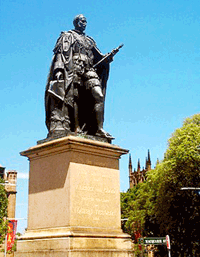
This statue by English sculptor William Theed (1804-91) stands in Queens Square however, when it was first unveiled by the Governor Sir John Young in April 1866, it was located at the entrance to Hyde Park. Albert the Good was the German born Prince Consort, the husband of Queen Victoria. He never visited Australia and was little known in this country except for his straight-laced moral attitude, his devotion to his wife and her deep love for him. He was the mastermind of the Crystal Palace exhibition of 1851 which triggered a succession of imitative expositions around the British Empire including one in Sydney and another in Melbourne. He contracted typhoid fever and died shortly before Christmas 1861. Prince Albert's death devastated Queen Victoria who suffered a nervous breakdown. For the rest of her life she slept with a photo taken of him as he lay dead above her head and had his clothes laid out on the bed and the basin in his room filled with fresh water every day until her death.
During World War I, moves were made to have the statue removed as Prince Albert was a German, and anti-German sentiment was running high at the time. Those arguing for the statue's removal also pointed out that Prince Albert had never set foot on Australian soil and had done nothing to promote or assist in Australia's development (hardly the truth). The statue was moved to an out of the way corner of the Botanical Gardens. After the war, it was moved to its present location opposite the one of his partner, Queen Victoria, and managed to survive another demand for its removal during World War II.
Bridge Street
Macquarie's Obelisk

The tiny triangle of park alongside Macquarie Place was once part of a garden where the produce for the Governor's table grew. It was from this spot that Macquarie measured distances within the colony of New South Wales and where in 1818 he commissioned Francis Greenway to design and build an obelisk to record those distances. Constructed by Sydney's foremost master Stonemason, Edward Cureton, at a cost of £85, its carefully hand carved letters and numerals reflect the limits of the little colony at that time. It records the mileages to Bathurst, Windsor, Parramatta, South Head and North Head of Botany Bay. Curiously Commissioner Bigge included the obelisk among his list of Gov. Macquarie's financial extravagances. Macquarie's justifiably indignant response described it as a "little unadorned obelisk, placed as it was, at a point whence distances were measured, and rendered at a trifling expense."
Thomas Sutcliffe Mort statue

Mort is remembered as one of Sydney's leading lights in the business world of 19th century Sydney. He arrived in the colony in 1838 when he was in his twenties. When his employer went to the wall, Mort went out on his own, carving out a name for himself as a leading importer/exporter, who is still remembered in Sydney's nomenclature - Mortdale, Mort's Dock and Goldsborough Mort. The statue, the work of sculptor Pierce F. Connolly, was erected after Mort's death and was unveiled in June 1883 by the Governor, Lord Loftus. It is located over the road from the office where he spent most of his working life. It stands where a drinking fountain was erected by Governor Macquarie to a design by Francis Greenway. The fountain became a target of Commissioner Bigge, a lawyer sent out by the British Government to report on Macquarie's governorship, who used it as an example of Macquarie's waste of public funds on unnecessary buildings and public utilities.
Hunter Street
P & O Building Fountain

Hunter Street, Sydney.
1963 Bronze. The object of a satirical photograph of the day showing three men, of various heights, lined up to void their bladders. Tom Bass.
Wynyard Park
Rev. Dr. John Dunmore Lang statue

Lang was a Presbyterian minister who had a major impact on life in 19th century Sydney. Born in 1799 at Greenock, Scotland, Lang was persuaded to emigrate to Australia by his younger, brother George, a settler from the old country who shared with his brother the moral degradation he believed existed in colonial New South Wales.
Whilst the location of Lang's statue is understandable - it is at the heart of his parish and within a stone's throw of the site of his church - its orientation is seen by many as disrespectful towards the man it honours. He has his back to the site of his Scots Church whilst he is facing Wynyard Park towards the Westpac Bank which in Lang's day was the Bank of New South Wales, an institution he loathed and criticised regularly. The statue was erected in 1891.
Loftus Street
Pioneer Women Memorial

A small bronze figure, erected in 1938, and created by British artist Paul Montford (1868-1938) located in the Memorial Garden to the Pioneer Women. The garden is built on the site of the Garden Palace Exhibition Building which was erected in 1879 to house the international exhibition of 1879.
Women At War Memorial

Dedicated to the memory of Australian women who served their country during World War II.
First Fleet Memorial

Darling Harbour
Circular Fountain

Darling Harbour water fountain has water running downwards in a circular motion.
Dancing Brolgas Fountain
Cockle Bay

Star City Fountain
Star City Casino, Foreshore Road, Pyrmont

Royal Botanical Gardens
Choragic Monument
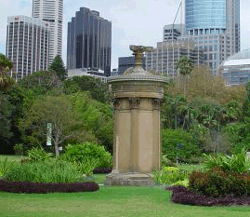
Created in 1870, this carved sandstone edifice is a replica of the eponymous ancient Monument to Lysicrates in Athens. It was executed by Walter McGill for Sir James Martin, Premier of New South Wales, 1870, for his residence in Macleay Street. Presented to the Royal Botanic Gardens in 1943.
Lewis Wolfe Levy Fountain
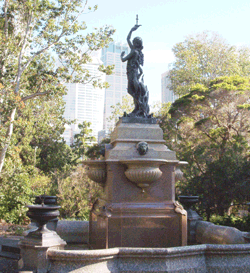
Art Nouveau fountain by CB Birch surmounted with a bronze statue of a water nymph with a heron and reeds and frogs at the base. The water nymph in the statue is believed to represent Diana, goddess of purity. The base is of red and grey granite which was cut and polished in Cornwall, England. The fountain was commissioned by the family of politician and businessman Lewis Wolfe Levy in 1889. Levy 91815-85) was a Jewish businessman and philanthropist who migrated from London in 1880.
George Street
Crossed Blades
Australia Square
Ancien demidure (steel). Created by Alexander Calder. 1967. Below: Australia Square fountain.

Wall of Water Fountain
Erected in 1976 at the station end of Town Hall Arcade, the simple but effective stone fountain is the work of Robert Woodward.

Queen Victoria Statue

Queen Victoria Building, George Street, Sydney
Having previously held pride of place in front of the Irish Parliament until its removal in 1947, this statue was found forgotten and neglected in the small Irish village of Daingean in 1983 after the Sydney City Council instigated a worldwide search for a statue of Queen Victoria to be placed alongside the Queen Victoria Building.
 Isley Isley
Queen Victoria Building, George Street, Sydney
Sculpture of Isley, Queen Victoria's beloved dog. It was incorporated into a wishing well made of stone from Blarney Castle, Ireland, and located at the Town Hall end of the Queen Victoria Building.
|
Royal Botanical Gardens
Lion Gate Lions

Two impressively carved stone lions guard the Lion Gate in the Macquarie Wall. The lions were bequeathed to the Gardens by Edward Sanders in 1912.
The Boxers Statues
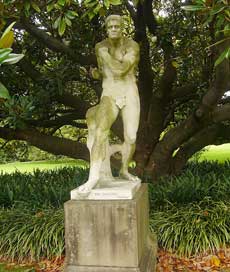
Two-metre high marble copies of 'The Boxers' by Antonio Canova (1802), which resides in The Vatican. This pair of statues has also been in the Gardens since the 1880s.
Linda da Chamounix and the Sweep Boy statue

Marble Victorian-era pair of statues of a young girl with a scarf, clogs and a hurdy gurdy (above) and a sweep boy, two characters from the Gaetano Donizetti opera, Linda da Chamounix. First performed in 1842.
Sweep Boy and Linda da Chamounix
These statues have been in the same place in the Gardens since the 1880s.
The Huntsman and Dogs
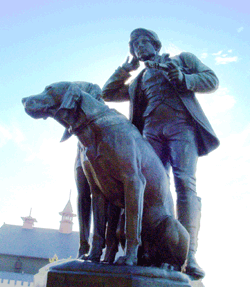
This recently restored statue by the French sculptor A. Jacquemart is 'imitation bronze' &emdash; an iron casting on which copper has been deposited by electrolysis. It was cast by the Val d'Osne Company c. 1879. The original is by French sculpture Henri Jacquemart (1824-96).
Captain Phillip Fountain

A huge fountain, erected in 1897 on the site of the former Garden Palace Exhibition Building after it burnt to the ground. Commemorating NSW's first governor, Arthur Phillip, it is the work of Italian sculptor Achille Simonetti, whose work was cast in Florence by F. Galli.
This elaborate fountain/memorial, the only one in Sydney to honour Phillip, was erected at a cost of £13,000 as part of the Queen Victoria Jubilee Celebrations. The larger than life statue of Phillip features him holding a scroll, with a flag furled by his side, facing Sydney Heads, perhaps looking for the Second Fleet which took so long coming from England. Around the plinth are white marble basins with water jets, bronze reliefs representing Patriotism, Education and Justice, flanked by Agriculture, Cyclops, Commerce and King Neptune. To complete the picture are paired dolphins and bronze plaques featuring Aborigines.
I Wish Statue

Pink concrete head of a girl by Arthur Fleischman, commissioned by Leo Buring, and mounted on a sandstone plinth (site of the first Wishing Tree), 1946. One of the few examples of modern art in the Gardens.
Allan Cunningham Monument
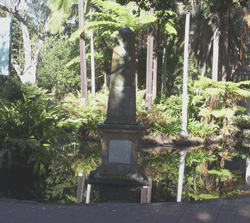
Located near the Gardens Restaurant in the Botanical Gardens is a sandstone obelisk to Allan Cunningham, the Garden's Superintendent in 1837. A botanist and explorer, he is credited with having discovered Queensland's Darling Downs. His ashes are buried beneath the monument.
Henry Kendall seat

This Art Deco style seat dedicated to Australian poet Henry Kendall was provided under the bequest of Mrs. A M Hamilton-Grey, an admirer of his poetry and was erected in 1940. The winged horses were carved by L. Bicego, 1939.
Magnolia and Palm
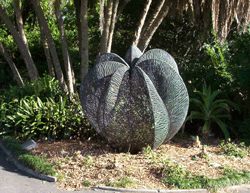
The pair of over scaled seed-like sculptures nestled beneath a magnolia and a palm tree in the Gardens are placed adjacent to the site of the First Farm in Sydney Cove. The forms reflect the organic flotsam washed up by the tide, blown by the wind and laden with the potential for transformation and new life. Created by Bronwyn Oliver.
Wuganmagulya (Farm Cove)
Farm Cove, Botanic Gardens
Wuganmagulya (Farm Cove) commemorates the historical and contemporary presence and importance of indigenous people to this part of Australia. In two sections of the pathway, figures from Sydney rock carvings - some of which no longer exist - are depicted in terrazzo and stained concrete using colours that reference the natural elements of the surrounding environment. Along the pathway kerb, the names of women and men, places, animals, tools and rituals from the many indigenous clans and language groups in the Sydney area are etched in red. The artwork pays homage to the Yura - the original clans of the site - as well as the clans who travelled great distances to attend ceremonies at Sydney Cove. It also acknowledges recent indigenous history such as the 1988 Long March of Peace, Justice and Hope. Created by Brenda L. Croft.
Folly for Mrs. Macquarie

Lawn 62, Botanical Gardens
Lachlan Macquarie and his wife governed in Sydney from 1810 to 1821. They arrived with a pattern-book for buildings in the neo-classical style and a desire to transform the colony. A sketch from the period indicates that Mrs. Macquarie had a folly constructed.
The design elements in Folly for Mrs. Macquarie echo those early aspirations, but also remind us that there was much folly in the way Britain colonised Australia. For example: the domed roof of Norfolk Island pine fronds refers to the colonists' regard for the tree, only to discover that its brittle timber was entirely unsuitable for ship masts; the ceiling is made from the bones and skulls of animals that once lived in the area; and the "Gothic windows" represent the barbed wire that divided up the land. Created by Fiona Hall.
Fleet Steps and Queen Elizabeth II Memorial
Steps constructed in 1908 to welcome the Great White American Fleet to Sydney. The adjacent wall commemorates the location where Queen Elizabeth II first set foot on Australian soil (asphalt) in 1954.
Boy Extracting Thorn

Damaged marble copy of 'Boy with Thorn' statue, imported from Italy, 1883.
Mare and Foal
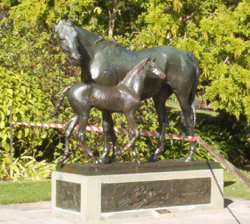
Bronze mare (La Reyna) and her foal by the French artist, Arthur J. le Duc, purchased in 1891, and donated to the Royal Botanic Gardens in 1958.
Earth Mother

Figurative sculpture by Helen Leete, from earth and sand laid in strata, imitating natural rock, 1993.
Memory is Creation without End
Spiral of sandstone blocks by Kimio Tsuchiya, relics of demolished buildings symbolising the circular connection of past, present, and future, 2000.
Venus 'Italica'
Marble replica of the Venus 'Italica' by the Italian sculptor Antonio Canova.
Satyr

Bronze cast of Frank 'Guy' Lynch's 1924 sculpture modelled from the artist's brother, whose death inspired Kenneth Slessor to write his poem 'Five Bells', 1977.
Daniel Solander bust and monument
Commemorates the first visit to Australian by a Swede. Solander was a member of James Cook's expedition aboard HMS Endeavour, which visited Botany Bay in April 1770. Solander was a leading botanist of his day. The monument was unveiled in 1982 by the King of Sweden, Carl XVI Gusaf, while visiting Australia. Another monument to Solander stands at Captain Cook's Landing Place in Kurnell near where Solander first came ashore.
Sensory Fountain

A spherical fountain designed to be touched, seen and heard - water begins to flow as you approach. Designed for the Herb Garden in 1994 by Victorian artist Tim Jones and made by Dave Mune at the Art Foundry in Victoria. The fountain is surrounded by a bronze ring of herbs drawn by Gardens' illustrator Marion Westmacott. Donated by the Australian Bank Ltd to commemorate their 10th anniversary and the 175th anniversary of the Royal Botanic Gardens.
Herb Garden Sundial
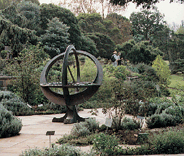
A splendid armillary sphere sundial, 2.4 m tall, 1.5 m internal ring diameter, weighing 1500 kg and made of silicon bronze, was designed specifically for the Herb Garden by John Ward and Margaret Folkard (Sundials Australia, Adelaide) in 1994. Features herbs modelled in clay in high relief by Adelaide sculptor Karen Rumpf from drawings by Gardens' illustrator Marion Westmacott. Both sundial and herb ring were cast by Dave Mune at the Art Foundry in Victoria. The sundial is dedicated to the memory of the late Malcolm Arnott (1910-1991).
Herb Garden Birdbath

Designed and made in 1994 for the Herb Garden by sculptor Peter Mueller and commemorating Hope Clayton (1907-1991), a friend of the Gardens.
The Domain
Robert Burns Statue
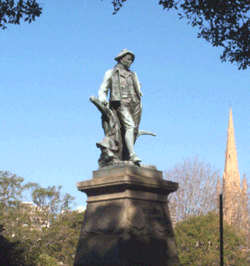
Art Gallery Road. A statue of one of Scotland's most famous sons, poet Robert Burns, was erected on a stone pedestal of Melbourne granite in 1905 for the Burns Memorial Committee by Englishman Frederick Pomeroy. It is appropriately located in what was known as Speaker's Corner, where in years gone by crowds gathered on Sunday afternoons to listen to speakers of all descriptions saying their piece.
Henry Lawson Statue

Art Gallery Road. Not too far away from Robert Burns is a statue of one of Australia's most celebrated writers and poets, Henry Lawson. Erected in 1931, it depicts Lawson beside a bushman with his swag and dog, a reference to his well loved humorous tale, The Loaded Dog. The last sculpture of Lawson's friend, artist George Washington Lambert, it was cast in bronze by AB Burton in London.
Sir John Robertson Statue
A life size bronze statue of the five times Premier of New South Wales and member of the first Legislative Assembly in 1856, Sir John Robertson, is located near the Art Gallery of NSW. As Lands Minister, Sir John Robertson who, as Lands Minister, approved the opening of the Domain at night to pedestrians in 1860. The statue, paid for by public subscription, was unveiled in 1904.
Dual Nature

Woolloomooloo Bay, Domain
These hybrids of marine, industrial and natural forms cling to the shoreline of Woolloomooloo Bay like abandoned hulks reflecting the maritime and cultural history of the site. The water sculptures are partly submerged at high tide and attached by wire to two derrick forms. The land based sculptures emit a pre-recorded soundscape entitled Ebb and Flow which relates to the history of people and shipping in the bay. Created by Nigel Helyer.
The Archaeology of Bathing

Woolloomooloo Bay, Domain
Woolloomooloo Bay has a long association with bathing. Prior to and after European settlement, the Cattigal people bathed there and it is along this shore that Sydney's first baths were built. Between 1833 and 1955, this section of the bay was the site of four separate ladies bathing establishments, including Mrs. Biggs' Ladies Baths and the Domain Baths for Ladies.
The Archaeology of Bathing traces elements of the former Domain Baths for Ladies: a floating jetty and marine piles evoke the memory of the boardwalk and mark the tidal change - a concrete path defines the poolside deck and changing cubicles - a bathing machine is evoked by the stair, cage and portal frame, reflecting the cultural attitudes towards bathing in Sydney at the time - lights in the portal frame signal morse code across the bay. Created by Robyn Backen.
Memory is Creation Without End

Tarpeian Way South
This spiral of sandstone blocks consists of relics carved by stonemasons from demolished buildings such as the Pyrmont Bridge. Once quarried for the city's early sandstone buildings the Tarpeian Way is now but a thin veneer of earth covering the Sydney Harbour Tunnel.
Memory is Creation Without End symbolises the circular connection of past, present and future. In salvaging and re-configuring the stones into this spiral unification of sculpture and landscape the artist endows them with new life, meaning and memory. By Japanese sculptor Kimio Tsuchiya.
Viva Voce Installation
Installation by Debra Phillips consisting of a red stepladder and five marble clad 'soapboxes' arranged amongst the trees at Speakers Corner in the Domain. Acknowledges the historical and contemporary importance of the area as a site of public oratory, as both the 'living voice and democratic heart of the city', 1999.
Police Memorial Wall
Memorial Wall to Police Officers who have lost their lives in the course of their duty, 1862-1998, erected 1999.
Veil of Trees

The passage of glass panels and new tree plantings reflects the botanical history of the Domain whilst rejuvenating species that were once found in the area. Consists of a meandering line of forest red gums with glass panels embedded with seeds, ash, honey, resin, and fragments of prose and poems by Australian writers, inspired by the landscape, 1999. Janet Laurence also created 'The Edge of Trees' in the forecourt of the Museum of Sydney. Installation by Janet Lawrence and Jisuk Han.
Pitt Street

Statue outside the Royal Exchange Building, Pitt Street, Sydney.
|